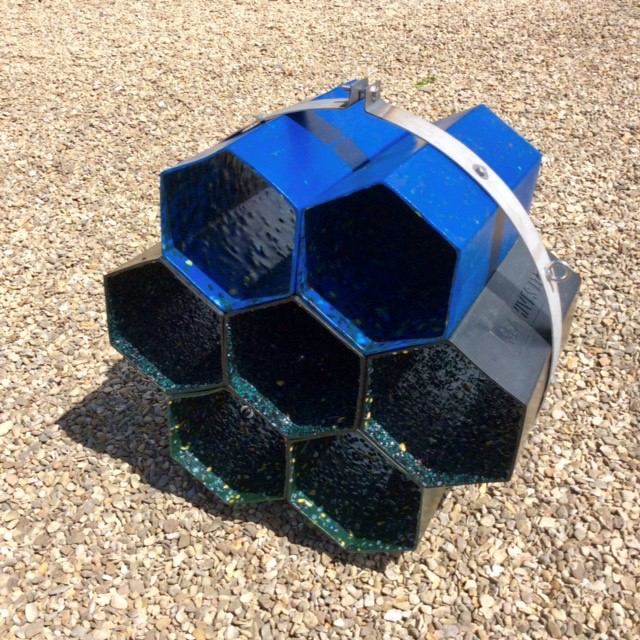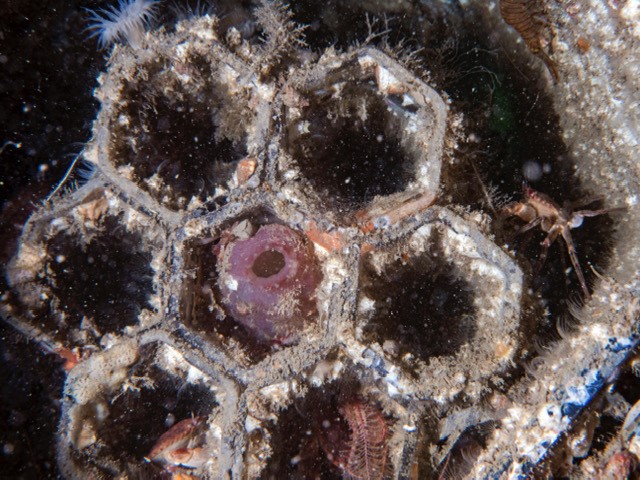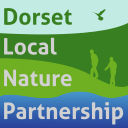Lee Hardy OBE JP, LNP Board Member, Dorset Catchment Partnerships, Dorset Coast Forum & Poole Harbour Commissioners
SeaHives are shelters designed to provide refuge for marine animals, somewhere to live, grow, breed and thrive, thereby increasing the total diversity and density of marine life in a local area.

The concept was born from the experience of SeaHives designer and keen diver Davis Francis. Diving around the UK and overseas he saw first-hand the damage caused to the marine environment by scallop dredging, explosive fishing and mangrove deforestation. But he also noted, in locations such as, Libya, Scotland and Papua New Guinea how hard surfaces, when orientated to a flow of plankton laden water, quickly become colonised by filter feeding animals, thereby initiating the creation of a new ecosystem.
The shelters are constructed from individual hexagonal tubes which themselves are created from recycled waste fishing gear. The tubes allow the design of the finished structure to be tailored to local marine conditions, and to be assembled and deployed by coastal communities with the minimum of training and tools. The instant impact is to provide shelter for juvenile fish in coastal areas where vegetation, especially Mangrove and Sea Grass, has been damaged or removed.

SeaHives were initially trialled in the aquaculture industry as shelters for cleaner fish used in salmon cages to remove parasites. The cleaner fish were mostly Wrasse and Lump Fish, and they immediately took to the SeaHives which were suspended in the salmon cages. Since then the shelters have been suspended at a depth of 20m in West Wales and at 2m, under the pier, in Weymouth Harbour. They have been quickly colonised by barnacles and tubes worms. These pioneering filter feeding animals create a base layer of material on the SeaHives which attract the juvenile stages of other animals like sponges, mussels and oysters. As well as removing organic particles from sea water, the calcareous shells of filter feeding animals are about 12% carbon by weight, so they also act as a long-term mechanism for capturing carbon from the environment.
The Weymouth Sea Life Centre has also included sections of SeaHive in one of their aquarium. Visitors are able to see how they are used by marine animals to gain greater access to the water column and the food it contains. Sea Anemones are proving to be particularly mobile in seeking, out the best places to capture passing plankton.

The latest deployment is in Poole Harbour at Poole Quay Boat Haven Marina. The SeaHives here have been purposely designed to fit under the marina pontoons. Not only does this provide an ideal location for colonisation, it also allows them to be easily monitored from the surface using a waterproof camera, which is ideal for educational purposes and to allow greater public accessibility. It is intended that the Poole Harbour deployment will offer a compelling case study for other marinas to adopt SeaHives in order to promote and enhance marine biodiversity.
The future for SeaHives is encouraging and there are opportunities to deploy them in a variety of locations at home and abroad. This includes under pontoons in marinas, or even attached to mooring buoys or decommissioned oil and gas rigs, in fact anywhere that lacks places for marine life to shelter, grow and mature.
For further information check: https://www.seahives.com or contact enquires@seahives.com.
